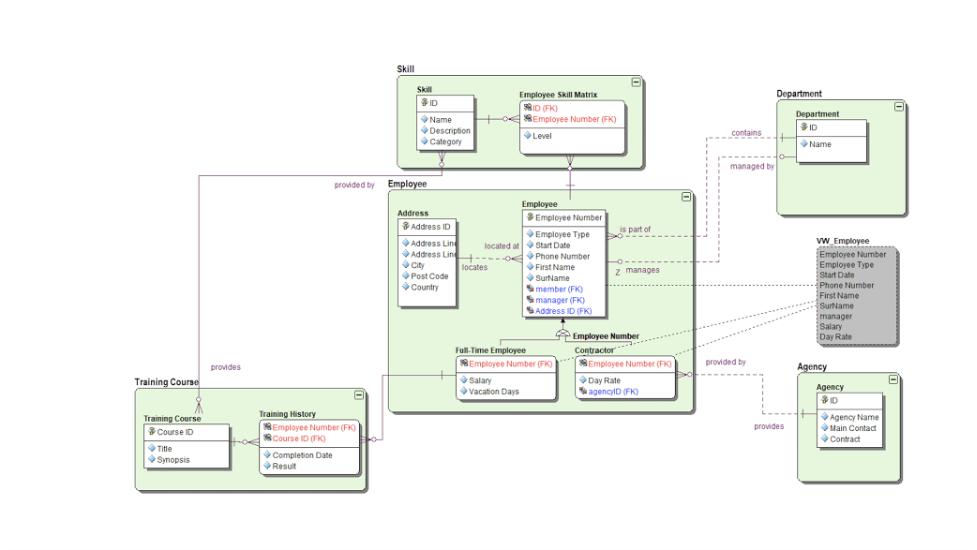
Three different types of data models exist, each of which plays a distinct role in data modeling.
They help an organization’s efforts in organizing, understanding, and making productive use of enterprise data resources.
There are three stages of data modeling, with each stage pertaining to its own type of data model – conceptual data models, logical data models and physical data models.
Organizations that take a linear approach to progressing through the stages of data modeling – using all three types of data model – benefit from a more complete understanding of their enterprise data assets and resources.
What are the 3 Types of Data Models?
Conceptual data models, logical data models and physical data models make up the three types of data model. While they require different approaches to build, each type of data model conveys the same information, from different perspectives. Leveraging all three types of data models helps address different stakeholders’ needs and levels of expertise.
This is because the three data models address the use of data assets from different degrees of abstraction. The models increase in complexity – starting with conceptual, through to physical data models. The models are used in different stages of the development process to foster the alignment of business goals and requirements with how data resources are used.
- Conceptual data models are used to communicate business structures and concepts at a high level of abstraction. These models are constructed without taking system constraints into account and are usually developed by business stakeholders and data architects to define and organize the information that is needed to develop a system.
- Logical data models are concerned with the types, attributes, and relationships of the entities that will inhabit the system. A logical model is often created by a data architect and used by business analysts. The goal is to develop a platform-independent representation of the entities and their relationships. This stage of data modeling provides organizations with insight pertaining to the limitations of their current technologies.
- Physical data models are used to define the implementation of logical data models employing a particular database management system (DBMS). They are built with the current – or expected to be – technological capabilities. Database developers and analysts work with physical data models to enact the ideas and processes refined by conceptual and logical models.
Concepts and system requirements are refined at each step as they move from conceptual models to logical models and are solidified in physical models.
Using the Right Type of Data Model
When done right, data modeling adds value to the modern enterprise. But to maximize that value, organizations need a solid understanding of the types of data model, and stages of data modeling. Different types of data models can be used to address the diverse audiences involved in the development of new database systems. It is important to use the correct type of data model to engage the business stakeholders involved in different stages of system development. The wrong type of data model will not convey the desired information to the intended audience nor be as useful in outlining and defining system requirements.
Conceptual Data Models
The initiative for a new database or application often comes from stakeholders trying to address evolving business requirements. These teams or individuals are interested in resolving a problem or streamlining a process from a very high-level perspective. The details of how the requirements will be met are irrelevant and will be handled by the appropriate technical parties.
Conceptual data models are the right vehicle for describing the purpose and components of the new system. A well-constructed conceptual model provides decision-makers with the information they need to approve or reject the proposed system.
Logical Data Models
Logical data models are then constructed by data architects in consultation with business analysts who understand the goals outlined in a conceptual model. At this level of abstraction, it becomes important to have a good understanding of the entities that will be represented in the system.
The purpose of logical models is to fully define the attributes and relationships exhibited by the identified entities. Ideally, this should be done while maintaining flexibility as to the database platform used for implementation. During the development and refinement of a logical model, it may become apparent that a particular database solution should be used for its implementation.
Physical Data Models
Physical data models turn the initial abstract concepts regarding the entities involved in the system into schemas that target a specific database platform. They are used by the teams responsible for implementing the ideas and creating viable systems to address business requirements.
Physical data models are necessarily the most technical type of model. Concepts that are easily communicated abstractly can be technically challenging to implement. Keeping this sensitive data safe is simply stated in a conceptual model, but not so easily laid out when considering its physical implementation.



